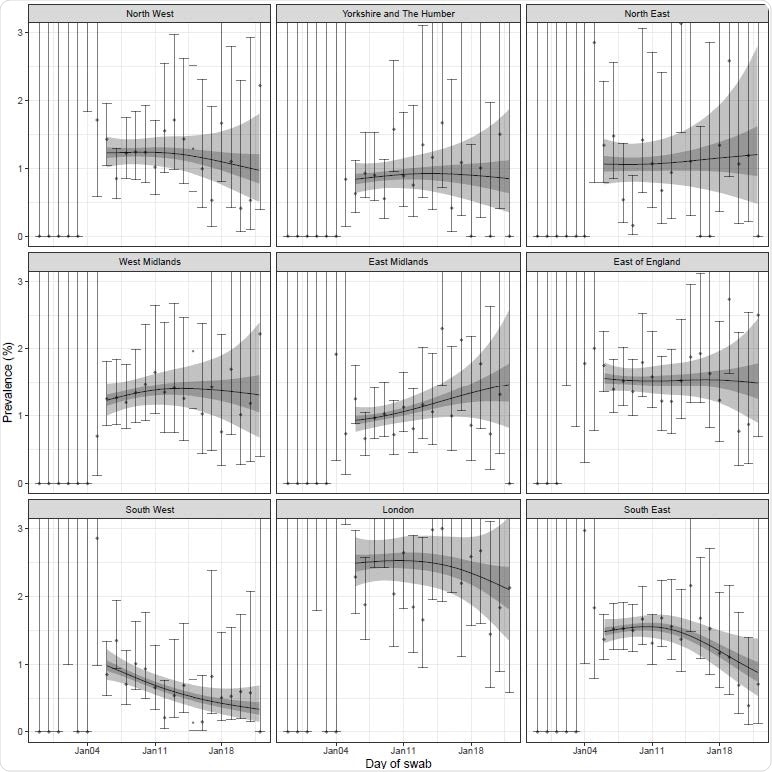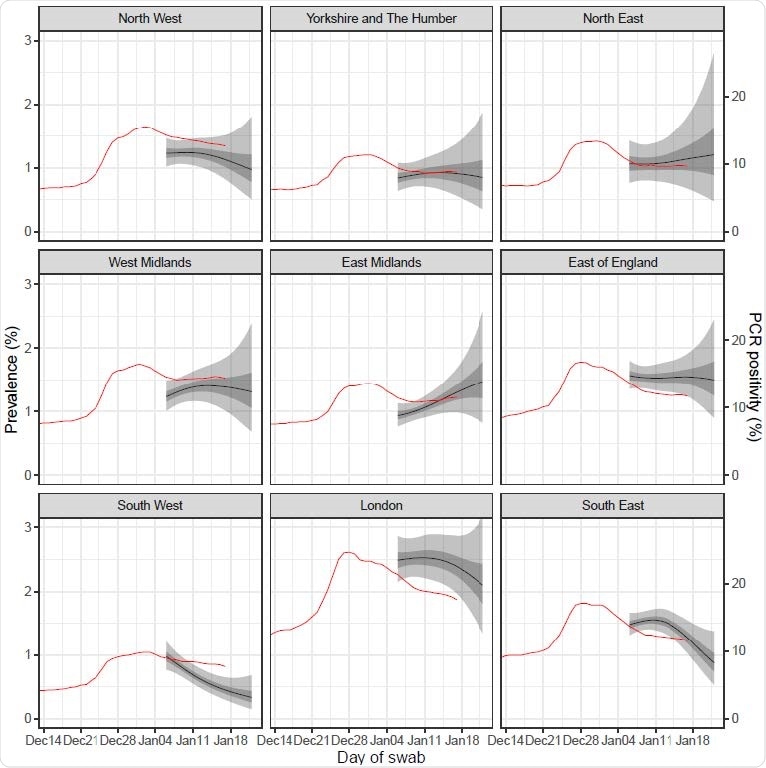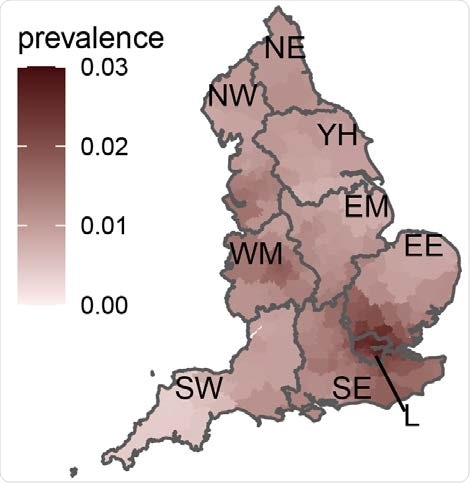The REACT-1 survey conducted in the United Kingdom demonstrates a high average prevalence of severe acute respiratory syndrome coronavirus 2 (SARS-CoV-2) infection in England during January 2021. The survey also indicates that a sustained reduction in infection prevalence is urgently needed to avoid burden on healthcare systems and reduce coronavirus disease 2019 (COVID-19)-related mortality. A detailed survey report is currently available on the medRxiv* preprint server.
REACT-1 survey, a community-level survey on COVID-19 prevalence was conducted using repeated cross-sectional analyses of random samples obtained from England's general population. In each round of the survey, respiratory swab samples and other COVID-19 related information were collected from 167,642 people.
The survey provided detailed information about SARS-CoV-2 prevalence in England between January 6 and January 22, 2021.
Important observations
According to the survey findings, about 2,282 of 167,642 samples tested positive for SARS-CoV-2, showing a prevalence of 1.57%. During the survey period, the reproductive number (a mathematical term indicating infectivity of a pathogen) was estimated to be 0.98. In general, the prevalence remained constant during the survey period, with a slightly increasing trend between January 6 and January 15. However, the prevalence appeared to decline afterward.
Compared to the 1st nation-wide lockdown, a significantly lower prevalence was observed during the 3rd lockdown. According to the scientists, this discrepancy may be associated with a higher level of mobility, the higher percentage of workplace and school attendees, and the higher infectivity of the new SARS-CoV-2 variant circulating during the 3rd lockdown in England.

Prevalence of swab-positivity for each region of England estimated using a pspline (with a constant second-order random walk prior distribution) fit to all 8 rounds of data (only shown for the duration of round 8) with central 50% (dark grey) and 95% (light grey) posterior credible intervals. Points show daily estimated unweighted prevalence with vertical solid lines showing 95% confidence intervals.

 *Important notice: medRxiv publishes preliminary scientific reports that are not peer-reviewed and, therefore, should not be regarded as conclusive, guide clinical practice/health-related behavior, or treated as established information.
*Important notice: medRxiv publishes preliminary scientific reports that are not peer-reviewed and, therefore, should not be regarded as conclusive, guide clinical practice/health-related behavior, or treated as established information.
Furthermore, a variation in SARS-CoV-2 prevalence was observed at the regional level, with significantly decreasing prevalence in the South West region and increasing prevalence in East Midlands. At the regional level, the highest prevalence (2.8%) was observed in London. Moreover, in this region, more than 2% and 4% prevalence were observed in the elderly (age range: 55 years and above) and younger (age range: 13 – 24 years) population, respectively. This indicates a rapidly increasing prevalence in London and nearby regions.

Regional comparison of REACT-1 estimated prevalence using a p-spline with central 50% (dark grey, left axis) and 95% (light grey, left axis) posterior credible intervals and routine PCR positivity for England (red, right axis) averaged over 7 days, plotted at the midpoint of the interval.
At the national level, the highest prevalence (2.4%) was observed in the low-risk age group (18 – 24 years). However, the prevalence was also high among people aged 65 years and above.
A significant correlation was observed between higher infection prevalence and family size, socioeconomic status of the neighborhood, and Black and Asian ethnicity. Compared to white people with a 1.4% prevalence, the prevalence in Black and Asian populations was estimated to be 3% and 2.8%, respectively. This indicates that these ethnic groups are at higher risk of SARS-CoV-2 infection.
The frequency of having a SARS-CoV-2-positive test result was significantly higher among healthcare workers, care home workers, and other frontline workers. This indicates a higher risk of occupational transmission of the virus.

Neighborhood prevalence of swab-positivity for round 8. Neighborhood prevalence calculated from nearest neighbors (the median number of neighbors within 30km in the study). Average neighborhood prevalence displayed for individual lower-tier local authorities. Regions: NE = North East, NW = North West, YH = Yorkshire and The Humber, EM = East Midlands, WM = West Midlands, EE = East of England, L = London, SE = South East, SW = South West. Data for unweighted point estimate of prevalence available in the supplementary data file.
Study significance
According to the survey findings, the prevalence of SARS-CoV-2 infection in England was exceptionally high in January 2021. This corresponds with the increased number of hospital and intensive care unit admissions and higher COVID-19-related mortality rate. Although a declining trend in infection prevalence was observed at the end of the survey period, the infection levels remain significantly higher than those observed during the 1st lockdown.
According to the scientists, pressure on healthcare systems and the mortality rate will continue to increase unless a sustained reduction in infection prevalence is achieved. In this scenario, proper implementation of control measures is highly recommended.

 *Important notice: medRxiv publishes preliminary scientific reports that are not peer-reviewed and, therefore, should not be regarded as conclusive, guide clinical practice/health-related behavior, or treated as established information.
*Important notice: medRxiv publishes preliminary scientific reports that are not peer-reviewed and, therefore, should not be regarded as conclusive, guide clinical practice/health-related behavior, or treated as established information.